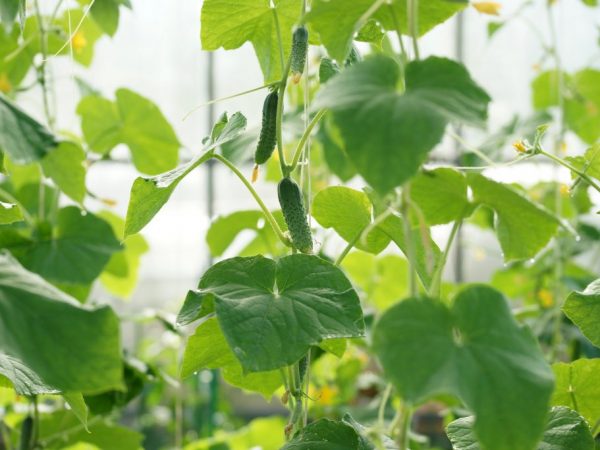Characteristics of Christina cucumbers
Cucumbers are widely distributed throughout the world. They are eaten raw or prepared for the winter. Cucumber variety Christina F1, due to its hybrid origin, has many positive qualities. The article provides a detailed description of the variety.

Characteristics of Christina cucumbers
Variety characteristic
Characteristics of Christina cucumbers:
- Productivity 10 kg from 1 m².
- Fruiting time is 40-42 days. The variety is considered to be early maturing.
- Fruits are of universal importance, but more often the species is used for conservation.
The plant is parthenocarpic. Planting is carried out both in the open and in closed ground. When growing on the site, it is recommended to cover the shoots with a film. For ease of maintenance, you can use trellis frames. This will contribute to the uniform development of the lashes.
Cucumbers Christina F1 grows in a temperate climatic zone. The culture endures unfavorable conditions and is suitable for summer cottages.
Description of the bush
The weave is medium-branched, with accelerated growth. Flowering female type. Ovaries form 2-3 fruits. This type of formation of cucumbers controls their growth, so the fruits do not outgrow with an uneven collection of greens.
Leaves are dark green in color, medium in size. Bushes are indeterminate, with a powerful central stem.
Description of fruits
The fruits have the following qualities:
- length - 8-10 cm;
- diameter - 2.2 cm;
- the weight of the greenery is 50-90 g;
The pulp has a crispy consistency, there are no voids and a bitter taste in it. Cucumbers are cylindrical. The skin is covered with small bumps and white thorns.
To get gherkins, harvest every two days. The variety is not suitable for growing pickles.
Bush care
F1 series hybrids are unpretentious, but favorable conditions will increase the quality of the crop. For good fruiting, cucumbers need:
- watering mode;
- top dressing;
- weeding and lashing.
Watering

The plant requires abundant watering
Cucumbers require a lot of liquid. Before the start of ovary formation, 6 liters should be applied in dry weather and 3 liters after rain. During the formation of cucumber greens, up to 10 liters are needed during drought and 6 liters after precipitation. It is recommended to irrigate the ground in the morning with warm water. Evening watering with early planting can lead to hypothermia of the roots due to temperature instability.
Loosening
Rain or watering will result in an earthen crust that inhibits shrub development. After irrigation, the soil must be loosened. However, weeding and hilling should be done carefully, since the root system is dangerously close to the soil surface.
Fertilizer
Fertilizer must be applied at least once during the entire growing season. Standard nitrogen and potash mixtures can be used as top dressing. You can also additionally fertilize plants while watering. To do this, prepare the following solutions:
- onion peel infusion;
- serum;
- diluted mullein and chicken droppings.
It should be remembered that animal feeding attracts many harmful insects. If neighboring areas are infected with a bear or whitefly, then chicken droppings should not be used as fertilizer.
Formation
Trimming the lashes can improve the quality of the cucumbers. The formation of the bush is carried out a week before the beginning of fruiting. It is necessary to cut off the lower lateral shoots. However, it is important to preserve the integrity of the central stem and upper lashes - they are responsible for the formation of future zelents.
Pests and diseases
The hybrid origin of the Kristina F1 variety allows it to avoid many common diseases. However, timely prevention will help to finally reduce the risk of infection and protect the bushes from pests. Processing is carried out once a season, before the start of fruiting.
The early maturity of the variety does not allow the use of potent agrochemicals. Such mixtures can lead to fruit toxicity. Most prophylactic solutions can be prepared at home using organic and mineral products:
- Powdery mildew is a common disease in cucumbers. The cause of the occurrence is hypothermia of the root system. Also, the disease occurs due to the greater amount of nitrogen in the soil. As a preventive measure, a milk-based solution with the addition of iodine and soap should be used.
- High humidity in the area leads to the appearance of peronosporosis. Fermented milk products will help prevent disease. They should be applied at the root of the bushes.
- White and gray rot affects the root system and stem. Excess moisture is the cause. In the fight against the disease, a urea solution should be used. For 10 liters of liquid, 10 g of the product is diluted.
Diseases are less of a threat to hybrid varieties. Pests cause great damage to the bushes. Some of them attack the stems and the root system. Others destroy the fruit.
The most common harmful insects are aphids and slugs. Pest prevention should be carried out in the fall, during the preparation of the soil for winter. Before freezing, the soil should be dug up and left to freeze. This is to destroy the larvae of pests and weed seeds.
It is also recommended to plant onions and garlic between the rows. The smell of these plants repels many insects. Some farmers plant dill for the same purpose. The seeds should be calcined immediately before planting. This will strengthen the immune system of the bushes.
Conclusion
Cucumber variety Christina F1 is suitable for private and commercial cultivation. In terms of fruit quality, this hybrid is not inferior to Western counterparts, but it is more unpretentious in care.


